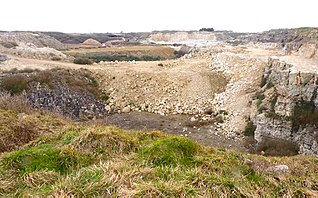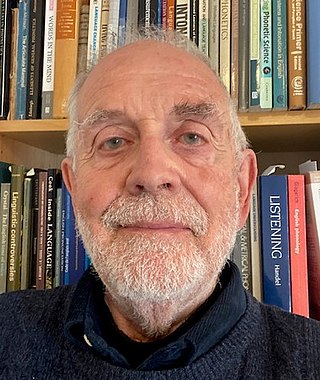
Portland Admiralty Roach is a kind of stone from the Isle of Portland used to construct "The Cobb", the well-known seawall at Lyme Regis in Dorset. The stone is rich in fossils often consisting of almost fifty percent fossilized remains with an average size of approximately 350 mm. The stone, which was quarried by Albion Stone, has a maximum bed height of 2 metres. The stone is renowned for being highly frost resistant and being able to withstand the chemical effects of seawater. The stone is an open textured oolitic limestone from the Portlandian formation formed during the Tithonian age, of the Late Jurassic epoch. It is formed from ooliths in a micrite matrix. There are many voids in the stone, caused by percolating rainwater dissolving all or parts of its many shell fossils, mainly bivalves and gastropods.

Portland Stone or Portland Stone Formation is a limestone formation from the Tithonian stage of the Jurassic period quarried on the Isle of Portland, Dorset, England. The quarries are cut in beds of white-grey limestone separated by chert beds. It has been used extensively as a building stone throughout the British Isles, notably in major public buildings in London such as St Paul's Cathedral and Buckingham Palace. Portland Stone is also exported to many countries—being used for example in the United Nations headquarters building in New York City.
Soleilmoon Recordings is an American record label that began in 1987 as a cassette label, operating from the back of a record shop called the Ooze in Portland, Oregon, US.

Bowers Quarry is an active stone quarry located on the Isle of Portland, Dorset, England. It is located on the western side of Portland, where it lies west of the villages Weston and Easton. The quarry is operated by Albion Stone and became the site of the first Portland Stone mine. In October 2002 the firm successfully initiated Portland's first ever underground mining operation, which was a precursor to Jordans Mine, which would start in 2008. It has also been the selected site for the planned Mass Extinction Memorial Observatory.

Beer Quarry Caves is a man-made limestone underground complex located about a mile west of the village of Beer, Devon, and the main source in England for beer stone. The tunnels resulted from 2,000 years of quarrying beer stone, which was particularly favoured for cathedral and church features such as door and window surrounds because of its colour and workability for carving. Stone from the quarry was used in the construction of several of southern England's ancient cathedrals and a number of other important buildings as well as for many town and village churches, and for some buildings in the United States. Extraction was particularly intense during the Middle Ages, but continued until the 1920s. An adit to another set of workings can be seen from the South West Coast Path east of Branscombe, having been exposed by a landslip in the late 18th century. The quarry is part of the Jurassic Coast, and is a Site of Special Scientific Interest (SSSI).
For schools of similar names, see Portland School.
Portland Bowers Basebed is a type of limestone from Bowers Quarry at the Isle of Portland in Dorset, southern England, on the Jurassic Coast, a World Heritage Site.
Portland Jordans Roach is a type of stone from the Isle of Portland used to construct parts of the refurbished "Green Park Tube Station", which is situated in London. The stone is a shelly roach. Jordans Roach has a maximum bed height of 2 metres and is a roach in which the shelliest parts seem to be towards the middle of the block.
The Spoken English Corpus (SEC) is a speech corpus used in corpus linguistics consisting of a collection of recordings of spoken British English compiled during the period 1984-7 through a collaboration, funded by IBM, between the Unit for Computer Research on the English Language (UCREL) at the University of Lancaster and the IBM Scientific Centre in Winchester. The corpus comprises 53 recorded passages, mainly recorded from the BBC, spoken in the accent usually referred to as Received Pronunciation, or RP. It covers categories such as commentary. news broadcast, lecture and dialogue. The corpus contains 52,637 words, in a recording time of 339 minutes. The compilation of the corpus is described by Lita Taylor in her 1996 article "The Compilation of the Spoken English Corpus." The whole corpus in print can be purchased at Routledge or Book Depository.

Culverwell Mesolithic Site is a Mesolithic settlement, located on the Isle of Portland, Dorset, England. It is found in the local area known as Culverwell, along the Portland Bill Road. It is within an area of unspoiled countryside, with no past quarrying. The site is maintained by the Association for Portland Archaeology – a small group dedicated to researching, investigating and excavating on Portland.

Jurassica is a planned visitor attraction in a disused quarry on the Isle of Portland, near Weymouth in Dorset, southern England. It is based on the Jurassic Coast, a World Heritage Site, and as a subterranean geological park, will largely present the prehistoric world. The attraction's location has been chosen as Yeolands Quarry, a now disused quarry that has been operational until the 21st century by Portland Stone Ltd. The quarry is 36 metres (120 ft) deep, 90 metres (300 ft) wide, and is on the eastern side of the island just south of The Grove village.

Perryfield Quarry is an active stone quarry and part butterfly nature reserve located on the Isle of Portland, Dorset, England. It is situated towards the middle of the island, east of the village of Weston and south of the hamlet of Wakeham. The reserve section is now a valued home for a number of butterfly species, while the working quarry area is one of the largest active quarries on Portland. The quarry is owned by Portland Stone Firms Ltd, along with Broadcroft and Coombefield Quarries. The firm is the largest landholder on the island.

The Princess and the Plumber is a 1930 American pre-Code comedy film directed by Alexander Korda and written by Howard J. Green. The film stars Charles Farrell, Maureen O'Sullivan, H. B. Warner, Joseph Cawthorn, Bert Roach and Lucien Prival. The film was released on December 21, 1930, by Fox Film Corporation.

Stonehills Mine is the first completely new mine on Portland. Albion Stone Plc began the process to open this mine began in 2015 and reserves are estimated to last for 50 years (2066). The planning application to begin work on Stonehills was submitted to the Dorset County Council in February 2001 and was finally approved in February 2005. The site is owned by the Crown Estate and the leased by Albion Stone plc who extract Portland Stone Whitbed and Portland Stone Basebed. Albion Stone Plc use room and pillar mining method of extraction which is already being carried out in their Jordans mine and Bowers Mine.

Jordans Mine is a Portland Stone mine on Portland. In 2016 it was the biggest mine for this stone, at some places 9 m (30 ft) high. It had previously been a quarry site since the 19th century. Following the successful planning application and the signing of the Unilateral Undertaking the mining began in 2008 and became 100% mining in early 2016. There are several miles of tunnels and this network dramatically reduces the impact on the environment and local residence

Peter John Roach is a British retired phonetician. He taught at the Universities of Leeds and Reading, and is best known for his work on the pronunciation of British English.










